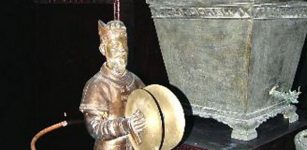Naglfar Nail-Ship Carries Demonic Forces To Ragnarok In Norse Beliefs
A. Sutherland - AncientPages.com - The last confrontation between friends of the gods and their enemies will occur in the field of Vigrid on the day of Ragnarok.
Naglfar (Old Norse "nail farer") is a ship made from dead men's nails in Norse myths and legends. It is attested in the Poetic Edda, based on earlier traditional sources and compiled in the 13th century, and Snorri's Prose Edda, written in the 13th century.
Naglfar and Fenrir on the Tullstorp Runestone in Scania, Sweden. image credit: Sven Rosborn - CC BY-SA 3.0
According to the Poetic Edda, the ship sails from the east and is packed with forces of evil and chaos.
Naglfar is on its way into the battle against the Aesir gods and will arrive on the shores of Midgard just in time for the Midgard serpent to emerge from the sea.
The ship's captain is the giant Hrym, who brings with him all the legions of the giants, while Loki takes the helm of the fatal boat full of giants. He steers Naglfar over the stormy and cold northern waters to Vigrid (Norse: Vígríðr), the plain where the decisive battle will occur. The gods and Vikings will also make their way to Vigrid.
Loki knows that his daughter Hel, queen of death and the underworld, and his brother Byleist are also on board Naglfar. A mischievous god, Loki, who symbolizes fire and deception, has never been a true friend of the gods. Loki will fight with Heimdallr (Heimdall), who illuminates the world and possesses foreknowledge, keen eyesight, and hearing; they both fall at Ragnarok.
The giant Surt is the ruler of Muspelheim, the land of primordial fire and flames. He participates in this worst of all battles, leading the fire giants and his servants against the gods. They are all well-trained by Surt and ready for the final confrontation on the day when the world as we know it will cease to exist. The giant Surt will fling fire over the whole Earth so that it burns. The son of Loki, Fenrir, will swallow Odin, killing him, but Fenrir will be victorious only for a moment because Odin's son Vidar will immediately avenge his great father.
Many must die at Ragnarok, and the ship Naglfar is also doomed. The ghastly Naglfar would slip its moorings in the violent seas whipped up by the furious sea monster Jormungandr.
At Ragnarok, all demonic forces will try to defeat the gods, according to an apocalyptic vision of Snorri Sturluson, an Icelandic historian, poet, politician, and author of the Prose Edda (or Younger Edda), among others. His vision includes fierce battles that will take place worldwide and last for three cold and dark years. Terrible winds will constantly blow in all directions, and there will be no summer because the sun will stop shining.
Nails, Naglfar, And Superstition
Superstitions have often accompanied ancient people in their daily lives. According to old Norse beliefs, no one in the Viking world needed to die with untrimmed nails. As Snorri says, there is one way to delay the ship's arrival.
The ship's size would depend on how many deceased had been buried with unpaired fingernails.
If someone dies with long fingernails, the surviving relatives of the dead must immediately cut them short before the deceased is laid to rest. Otherwise, their nails will be used to build the Naglfar larger and more robust.
The ancient Vikings believed that this action could significantly delay the construction of the ghost ship and the day of the world's end.
Written by – A. Sutherland - AncientPages.com Senior Staff Writer
Updated on September 15 , 2022
Copyright © AncientPages.com All rights reserved. This material may not be published, broadcast, rewritten or redistributed in whole or part without the express written permission of AncientPages.com
More From Ancient Pages
-
 Surprising Mask Of A Human Face Found On Cistern Wall In The Ancient City Of Ptolemais
Archaeology | Jan 17, 2025
Surprising Mask Of A Human Face Found On Cistern Wall In The Ancient City Of Ptolemais
Archaeology | Jan 17, 2025 -
 Exceptional Collection Of Well-Preserved Stucco Masks Of The Mayan Kingdom Reveal Their Secrets
Archaeology | Dec 5, 2022
Exceptional Collection Of Well-Preserved Stucco Masks Of The Mayan Kingdom Reveal Their Secrets
Archaeology | Dec 5, 2022 -
 Did The Plague Of Athens Come From Egypt Or Is It A Myth?
Archaeology | Dec 13, 2023
Did The Plague Of Athens Come From Egypt Or Is It A Myth?
Archaeology | Dec 13, 2023 -
 Four Roman-Era Brooches And A Ring Found In The Borki Forest, Poland
Archaeology | Mar 15, 2024
Four Roman-Era Brooches And A Ring Found In The Borki Forest, Poland
Archaeology | Mar 15, 2024 -
 Fragarach: Supernatural Sword That Controlled Winds, Cut Through Wood, Metal And Bricks In Irish Myths And Legends
Celtic Mythology | May 14, 2020
Fragarach: Supernatural Sword That Controlled Winds, Cut Through Wood, Metal And Bricks In Irish Myths And Legends
Celtic Mythology | May 14, 2020 -
 Solving The Bark Painting Mystery In Australia
Archaeology | Feb 23, 2023
Solving The Bark Painting Mystery In Australia
Archaeology | Feb 23, 2023 -
 On This Day In History: Mount Tambora Volcano Begins A Three-Month-Long Eruption – On Apr 10, 1815
News | Apr 10, 2017
On This Day In History: Mount Tambora Volcano Begins A Three-Month-Long Eruption – On Apr 10, 1815
News | Apr 10, 2017 -
 Camazotz: ‘Death Bat’ Vampire God In Ancient Maya Beliefs
Featured Stories | Jun 8, 2017
Camazotz: ‘Death Bat’ Vampire God In Ancient Maya Beliefs
Featured Stories | Jun 8, 2017 -
 On This Day In History: Treaty Of Seville Signed – On Nov 9, 1729
News | Nov 9, 2016
On This Day In History: Treaty Of Seville Signed – On Nov 9, 1729
News | Nov 9, 2016 -
 Apedemak: Did The Three-Headed Lion War God Of Kush Originate From Ancient India?
Featured Stories | Jul 21, 2021
Apedemak: Did The Three-Headed Lion War God Of Kush Originate From Ancient India?
Featured Stories | Jul 21, 2021 -
 Taíno Indians Are Not Extinct – Ancient Tooth Reveals Indigenous Americans Still Have Living Descendants In The Caribbean
Archaeology | Feb 21, 2018
Taíno Indians Are Not Extinct – Ancient Tooth Reveals Indigenous Americans Still Have Living Descendants In The Caribbean
Archaeology | Feb 21, 2018 -
 First Near-Complete Sauropod Dinosaur Skull Found In Australia Hints At Ancient Links Between Continents
Featured Stories | Apr 13, 2023
First Near-Complete Sauropod Dinosaur Skull Found In Australia Hints At Ancient Links Between Continents
Featured Stories | Apr 13, 2023 -
 Mysterious Steles Of Mongolia – ‘Deer Stones’ In The Tsatsyn Ereg Necropolis
Archaeology | Jan 23, 2019
Mysterious Steles Of Mongolia – ‘Deer Stones’ In The Tsatsyn Ereg Necropolis
Archaeology | Jan 23, 2019 -
 LIDAR Discovers Lost Colonial City Hidden In The Amazon Rainforest
Archaeology | Oct 22, 2024
LIDAR Discovers Lost Colonial City Hidden In The Amazon Rainforest
Archaeology | Oct 22, 2024 -
 Roman Treasures Unearthed At Ancient Site Of Tiel, Netherlands
Archaeology | Apr 2, 2017
Roman Treasures Unearthed At Ancient Site Of Tiel, Netherlands
Archaeology | Apr 2, 2017 -
 Ancient Textile Mystery: King Canute Enshrined In His Own Clothes But Found In His Brother’s
Artifacts | Oct 5, 2020
Ancient Textile Mystery: King Canute Enshrined In His Own Clothes But Found In His Brother’s
Artifacts | Oct 5, 2020 -
 Remains Of Graeco-Roman Temple Discovered Near Egypt’s Siwa Oasis
Archaeology | Apr 6, 2018
Remains Of Graeco-Roman Temple Discovered Near Egypt’s Siwa Oasis
Archaeology | Apr 6, 2018 -
 Highly Advanced Robots In Ancient China
Ancient Technology | Aug 7, 2015
Highly Advanced Robots In Ancient China
Ancient Technology | Aug 7, 2015 -
 Nurarihyon: Powerful Demon Of Obscure Origin, Chief Of All Yokai
Featured Stories | Nov 6, 2024
Nurarihyon: Powerful Demon Of Obscure Origin, Chief Of All Yokai
Featured Stories | Nov 6, 2024 -
 Ancient DNA Solves The Mystery Of Mitochondrial Eve And Human Evolution?
Archaeology | Sep 21, 2022
Ancient DNA Solves The Mystery Of Mitochondrial Eve And Human Evolution?
Archaeology | Sep 21, 2022

